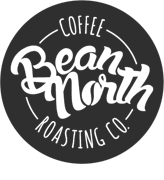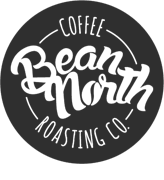Cupping for Quality
Bean North strives to roast only high quality certified organic fair trade coffee. In the trade of specialty coffees, the cupping test is the ultimate test carried out by a potential buyer to determine whether to import a coffee. An experienced cupper is able to determine the vast array of defects through taste and smell. Al our coffees are cupped in Cooperative Coffees Canada's Le Labo Equitable - read more about this cupping lab.
Preparation
One must first ensure that the coffee that is going to be sampled receives a proper roast, which would be a light to medium roast. If the coffee is roasted too dark, many of the good and bad flavours that determine a coffee's quality are burned away. The ideal Agtron score for a sample roast should hover around 45. A small amount of coffee should be roasted because if the sample is too big, control and consistency may be lost in the sample roast. Once roasted, the coffee should be left overnight to cool for cupping the following day.
About 12 to 12.5 grams of coffee are to be ground per cup in the cupping table, depending on the size of the cup, as long as the standard brew formula of 8.25g per 125mL of water is used. Five cups per lot sample are laid out for cupping.
The Cupping
-
Stage 1: "Fragrance"
Fragrance refers to the olfactory characteristics of the dry coffee grounds. A cupper will bend down and inhale the fragrance of the coffee, noting down its notes and particularities in a cupping sheet. -
Stage 2: "Aroma"
The aroma refers to the smell of the coffee while it is in its wet stage. When the water temperature has reached 92ºC-96ºC it is poured into the cups. The cups are then left for 3-4 minutes to allow for the infusion. The cupper will smell the coffee at this point, and record notes. Then the cupper will bring his nose to the top layer of the coffee (known as the "crust") and break it with his cupping spoon. The break releases a lot of important smells. The cupper will then record the notes he detected. -
Stage 3: "Flavour"
The coffee is allowed 3-5 minutes to cool down. During this time the broken crust is removed with spoons to begin flavour testing. When cool, the cupper dips his spoon in the coffee and quickly slurps it up, making sure the coffee touches every part of his tongue. Cuppers may do this multiple times while taking notes. It is important to note that when cupping multiple samples and multiple cups, the cupper must dip his spoon in hot water to remove any trace from the previous cupped sample. Hot water bowls can be laid out throughout the cupping table and filled with the same water used to brew the samples.
Grading the Coffee After these three tests the coffee is graded based on eleven parameters which are the following, obtained from the November 2009 SCAA Cupping Protocols handbook:
-
Fragrance/Aroma - The aromatic aspects include fragrance (defined as the smell of the ground coffee when still dry) and aroma (the smell of the coffee when infused with hot water). One can evaluate this at three distinct steps in the cupping process: (1) sniffing the grounds placed into the cup before pouring water onto the coffee; (2) sniffing the aromas released while breaking the crust; and (3) sniffing the aromas released as the coffee steeps. Specific aromas can be noted under “qualities” and the intensity of the dry, break, and wet aroma aspects noted on the 5-point vertical scales. The final score given should reflect the preference of all three aspects of a sample’s fragrance/aroma.
-
Flavour - Flavour represents the coffee's principal character, the "mid-range" notes, in between the first impressions given by the coffee's first aroma and acidity to its final aftertaste. It is a combined impression of all the gustatory (taste bud) sensations and retro-nasal aromas that go from the mouth to nose. The score given for flavour should account for the intensity, quality and complexity of its combined taste and aroma, experienced when the coffee is slurped into the mouth vigorously so as to involve the entire palate in the evaluation.
-
Aftertaste - Aftertaste is defined as the length of positive flavour (taste and aroma) qualities emanating from the back of the palate and remaining after the coffee is expectorated or swallowed. If the aftertaste were short or unpleasant, a lower score would be given.
-
Acidity - Acidity is often described as "brightness" when favourable or “sourness” when unfavourable. At its best, acidity contributes to a coffee's liveliness, sweetness, and fresh fruit character and is almost immediately experienced and evaluated when the coffee is first slurped into the mouth. Acidity that is overly intense or dominating may be unpleasant, however, and excessive acidity may not be appropriate to the flavour profile of the sample. The final score marked on the horizontal tick-mark scale should reflect the panelist’s perceived quality for the Acidity relative to the expected flavour profile based on origin characteristics and/or other factors (degree of roast, intended use, etc.). Coffees expected to be high in Acidity, such as a Kenya coffee, or coffees expected to be low in Acidity, such as a Sumatra coffee, can receive equally high preference scores although their intensity rankings will be quite different.
-
Body - The quality of Body is based upon the tactile feeling of the liquid in the mouth, especially as perceived between the tongue and roof of the mouth. Most samples with heavy Body may also receive a high score in terms of quality due to the presence of brew colloids and sucrose. Some samples with lighter Body may also have a pleasant feeling in the mouth, however. Coffees expected to be high in Body, such as a Sumatra coffee, or coffees expected to be low in Body, such as a Mexican coffee, can receive equally high preference scores although their intensity rankings will be quite different.
-
Balance - How all the various aspects of flavour, aftertaste, acidity and body of the sample work together and complement or contrast to each other is balance. If the sample is lacking in certain aroma or taste attributes or if some attributes are overpowering, the Balance score would be reduced.
-
Sweetness - Sweetness refers to a pleasing fullness of flavour as well as any obvious sweetness and its perception is the result of the presence of certain carbohydrates. The opposite of sweetness in this context is sour, astringency or “green” flavours. This quality may not be directly perceived as in sucrose-laden products such as soft drinks, but will affect other flavour attributes. 2 points are awarded for each cup displaying this attribute for a maximum score of 10 points.
-
Clean Cup - Clean Cup refers to a lack of interfering negative impressions from first ingestion to final aftertaste, a “transparency” of cup. In evaluating this attribute, notice the total flavour experience from the time of the initial ingestion to final swallowing or expectoration. Any non-coffee like tastes or aromas will disqualify an individual cup. 2 points are awarded for each cup displaying the attribute of clean cup.
-
Uniformity - Uniformity refers to consistency of flavour of the different cups of the sample tasted. If the cups taste different, the rating of this aspect would not be as high. 2 points are awarded for each cup displaying this attribute, with a maximum of 10 points if all 5 cups are the same.
-
Overall - The overall scoring aspect is meant to reflect the holistically integrated rating of the sample as perceived by the individual panelist. A sample with many highly pleasant aspects, but not quite “measuring up” would receive a lower rating. A coffee that met expectations as to its character and reflected particular origin flavour qualities would receive a high score. An exemplary example of preferred characteristics not fully reflected in the individual score of the individual attributes might receive an even higher score. This is the step where the panelists make their personal appraisal.
-
Defects - Defects are negative or poor flavours that detract from the quality of the coffee. These are classified in 2 ways. A taint is an off-flavour that is noticeable, but not overwhelming, usually found in the aromatic aspects. A “taint” is given a “2” in intensity. A fault is an off-flavour, usually found in the taste aspects, that is either overwhelming or renders the sample unpalatable and is given an intensity rating of “4”. The defect must first be classified (as a taint or a fault), then described (“sour,” “rubbery,” “ferment,” “phenolic” for example) and the description written down. The number of cups in which the defect was found is then noted, and the intensity of the defect is recorded as either a 2 or 4. The defect score is multiplied and subtracted from the total score according to directions on the cupping form.





